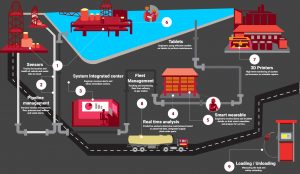What are the most common use cases for sensors and IoT for oil and gas?
Common uses for sensors and IoT technology in the oil and gas industry are remote monitoring and safety. The oil and gas industry operates equipment in isolated and often dangerous locations. Sensor technology can provide real-time monitoring around the clock while minimizing the number of times technicians must enter risky situations.
Remote Monitoring
Most oil fields are in remote areas. These locations require immense time and resources for monitoring extraction equipment. IoT and sensor technology are a comparatively inexpensive means of constant monitoring with fewer safety risks.
This technology can immediately notify oil and gas companies of spills and emergency situations. That means a faster response rate and less damage.
Predictive Maintenance
When large oil and gas equipment breaks down, the entire system simply stops producing. The industry as a whole loses billions of dollars each year as a result.
IoT and sensors can trigger alerts when things like flow rates fall out of ideal ranges. This data is sent back to a central system where management authorizes the required maintenance.
Sensors can also monitor and record tank level pressures, alerting companies of safety hazards before accidents occur.
IoT and sensor technology allow oil and gas companies to adopt predictive maintenance programs. Companies won't waste money and time or take unnecessary risks by over-maintaining. They also avoid incurring production losses, downtime, and safety incidents by under-maintaining.
Human Safety
A career in oil and gas is a dangerous one. IoT and sensor technology can significantly reduce the risk of dangerous exposures as well as improve overall safety.
First, technology can pinpoint the best times a technician is actually required to travel to a dangerous site. At the same time, remote monitoring can inform technicians if the area is generally safe before work begins.
Second, teams can use drones and robotic technology in extremely dangerous situations such as drilling and working in shale wells. Manufacturers and engineers are also developing automated trucks to transport oil as well.
Finally, wearable technology can help monitor the actual environment that maintenance technicians are working in. These sensors can alert them to dangerous gases and leaks before they fall ill.

Want to keep reading?
How IoT Works: The Four Factors That Make IoT Possible
The 6 most common myths about oil and gas debunked
What industries can use IIoT sensors?
4,000+ COMPANIES RELY ON ASSET OPERATIONS MANAGEMENT
Leading the Way to a Better Future for Maintenance and Reliability
Your asset and equipment data doesn't belong in a silo. UpKeep makes it simple to see where everything stands, all in one place. That means less guesswork and more time to focus on what matters.

![[Review Badge] Gartner Peer Insights (Dark)](https://www.datocms-assets.com/38028/1673900494-gartner-logo-dark.png?auto=compress&fm=webp&w=336)
